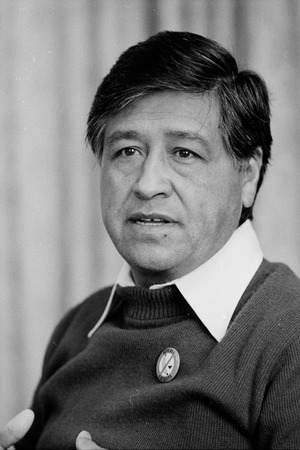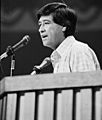César Chávez facts for kids
Quick facts for kids
César Chávez
|
|
|---|---|

Chávez in 1979
|
|
| Born |
Cesario Estrada Chávez
March 31, 1927 Yuma, Arizona, U.S.
|
| Died | April 23, 1993 (aged 66) San Luis, Arizona, U.S.
|
| Resting place | César E. Chávez National Monument |
| Occupation |
|
| Spouse(s) | Helen Fabela Chávez |
| Children | 8 |
| Awards |
|
César Chávez (born Cesario Estrada Chávez March 31, 1927 – April 23, 1993) was an American labor leader and civil rights activist. Along with Dolores Huerta, he co-founded the National Farm Workers Association (NFWA), which later merged with the Agricultural Workers Organizing Committee (AWOC) to become the United Farm Workers labor union.
Contents
Early years
Cesario Estrada Chávez was born in Yuma, Arizona on March 31, 1927. He was raised as a Roman Catholic. He had two sisters, Rita and Vicki, and two brothers, Richard and Librado. The Chávez family joined other migrant families who traveled to California during the Great Depression. He moved many times with his family, going to locations where farm work was available. The working conditions were not good. The whole family had to work hard for very little pay. To entertain himself, he played handball and listened to boxing matches on the radio.
Students were not allowed to speak Spanish at the first school Cesario attended in Arizona. He was expected to change his name to César. In California, he moved schools many times, spending the longest time at Miguel Hidalgo Junior School. His grades were average, although he excelled at mathematics. He graduated from junior high in June 1942 and became a full-time farm laborer.
Chávez enlisted in the U.S. Navy in 1944 and received an honorable discharge in 1946. He returned home to California and continued farm work.
Activism
While in California, Chávez got involved in the Community Service Organization (CSO) and helped laborers register to vote.
In 1959, he became the CSO's national director. In 1962, he left the CSO to co-found the NFWA, based in Delano, California. He began an insurance scheme, a credit union, and the El Malcriado newspaper for farm workers. He also began organizing strikes among farm workers.
Delano grape strike
In September 1965, Filipino American farm workers, organized by the Agricultural Workers Organizing Committee (AWOC), started the Delano grape strike to protest for higher wages. Chávez and his largely Mexican-American supporters voted to support them. The strike covered an area of over 400 square miles. The strike included picketing and a 340-mile march to Sacramento.
During the grape strike, Chávez's NFWA merged with Larry Itliong's AWOC to form the United Farm Workers (UFW) labor union in 1967. Chávez used nonviolent tactics to pressure farm owners into granting strikers' demands.
On July 29, 1970, the Delano growers signed contracts with the union in front of the press. These contracts agreed to wage rises for pickers, the introduction of a health plan, and new safety measures regarding the use of pesticides on the crop.
Final years and death

Over the next decades, César continued to grow the union. He kept fighting for the rights of farm workers. He believed that boycotts and marches were the best way to get the change.
Chávez's mother died in December 1991, aged 99. The following year, in September 1992, Chávez's mentor Ross died. Chávez died in bed on April 23. He was aged 66.
Chávez's body was flown to Bakersfield aboard a chartered plane. The family stated that he had died of natural causes. As his body lay in state, tens of thousands of people visited it. A funeral procession took place in Delano, with 120 pallbearers taking turns to carry the coffin. Chávez was then buried in a private ceremony at La Paz.
Personal life
Chávez married Helen Fabela in 1948. The couple moved to The couple moved to San Jose, California. With his wife, he had eight children: Fernando (b.1949), Sylvia (b.1950), Linda (b.1951), Eloise (b.1952), Anna (b.1953), Paul (b.1957), Elizabeth (b.1958), and Anthony (b.1958).
Helen avoided the limelight, a trait that Chávez admired. While he led the union, she focused on raising the children, cooking, and housekeeping.
Chávez's granddaughter Julie Chávez Rodriguez is an American political rights activist. From 2008 to 2016, she served in the Obama administration. In 2022, President Biden promoted her to be a senior advisor to the president, a senior staff position. On April 25, 2023, it was announced that Rodriguez would serve as Campaign Manager for Joe Biden 2024 presidential campaign. This is the first time a Latina was selected to run the campaign of an incumbent president.
Personality
Physically, Chávez was short, and had jet-black hair. He was quiet, outwardly shy, and unimposing. Like many farm laborers, he experienced severe back pain throughout his life.
He was self-conscious about the fact that he only graduated from eighth grade. He was not a good speaker and disliked telephone conversations, but he was good at reading the people around him. He did not like to trust others with jobs he could do. He was good at making quick decisions.
Legacy
Chávez is respected in California and other states. In 2000, California's state legislature started a holiday to honor him. The holiday is on March 31, Chávez's birthday. This is the first time that a US public holiday honored a Mexican American or a union leader.
Many cities have streets or places named for him. These cities include San Francisco, Los Angeles, Albuquerque, New Mexico, Austin, Texas, Chicago, Illinois, Milwaukee, and Salt Lake City.
In 1998, he was inducted into the Hall of Honor by the United States Department of Labor.
Interesting facts about César Chávez

- Chávez was named for his paternal grandfather, Cesario Chávez, a Mexican who had crossed into Texas in 1898.
- As a child, Chávez was nicknamed "Manzi" because he liked manzanilla tea.
- He was a devoted Catholic and rarely missed Mass.
- In 1970, he became a vegetarian.
- Chávez loved the music of Duke Ellington and big band music.
- He enjoyed dancing, although he suffered from chronic back pain.
- He was also an amateur photographer, and a keen gardener, making his own compost and growing vegetables.
- For much of his adult life Chávez kept German shepherd dogs for personal protection.
- He served in the United States Navy from 1944 to 1946. He was promoted to the rank of seaman first class.
- Chávez was greatly influenced by the ideas of Indian independence leader Mahatma Gandhi. He kept a large portrait of Gandhi in his office, alongside another of Martin Luther King, and busts of both John F. Kennedy and Abraham Lincoln.
- In 1994, he posthumously received the Presidential Medal of Freedom.
- In 2014 President Barack Obama proclaimed March 31 "César Chávez Day" in the United States.
- His slogan in 1972 was “Si, se puede,” Spanish for “Yes, it can be done.” This became the Latino civil rights motto and also inspired Barack Obama's “Yes we can” motto from his presidential campaign in 2008.
Images for kids
-
Chávez's support for the Filipino government of Ferdinand Marcos (pictured) brought strong criticism.
-
The César Chávez Memorial at San José State University by Judy Baca.
-
Illustration of labor leader César Chávez by Manuel Gregorio Acosta, was on the cover of Time, published July 4, 1969
See also
 In Spanish: César Chávez para niños
In Spanish: César Chávez para niños

















